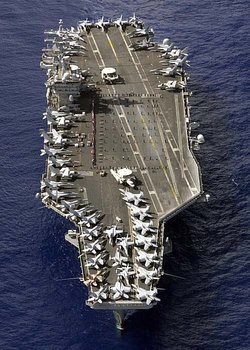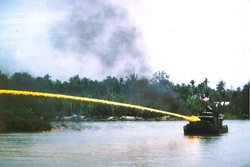Navy
|
|
- For other uses, see Navy (disambiguation).
 U.S. Navy supercarrier USS Nimitz on November 3, 2003. Approximately fifty aircraft can be counted on deck.
U.S. Navy supercarrier USS Nimitz on November 3, 2003. Approximately fifty aircraft can be counted on deck.
A Navy is the branch of a country's military forces principally designated for naval warfare, namely lake- or ocean-borne combat operations and related functions. It includes operations conducted by surface vessels (ships), submarine vessels, and seaborne aviation, as well as ancillary support, communications, training, and other fields; recent developments have included space-related operations.
| Contents |
History
Main article: Naval warfare
Naval warfare first developed whenever humankind conducted fighting from water-borne vessels. Prior to the introduction of the cannon, and ships with sufficient capacity to carry the large guns, naval warfare primarily involved ramming and boarding actions. The mass and deck space required to carry a large number of cannon made oar-based propulsion impossible, and ships came to rely primarily on sails.
The development of large capacity, sail-powered ships carrying cannon led to a rapid expansion of European naval power, and ultimately helped propel the age of exploration and colonialism. Britain gradually gained an ascendancy over rival powers Spain, Holland, and France, becoming the world's dominant naval power.
The next stage in the evolution of naval warfare was the introduction of metal plating along the hull sides. The increased mass required steam-powered engines, which resulted in an arms race between armor thickness and firepower. Another significant improvement came with the invention of the rotating turrets, which allowed the guns to be aimed independently of ship movement. The battle between the Merrimack and the Monitor during the American civil war is often cited as the beginning of this age of maritime conflict.
By the late 20th century, naval power had seen a great and varied evolution through history, and remains today a major element in the military and strategic security power of a a country's power projection capabilities, though some would suggest its importance has declined in the wake of the development of military aviation and air power. Many leading thinkers, however, suggest that navies are more important today than ever and will soon surpass armies once again as the main measure of a nation's military might.
Contemporary naval forces
Naval tactics and strategy
Main article: Modern naval tactics
It is tempting to regard modern naval combat as the purest expression of tactics. This assumes there is no cover, there are no civilians and the area of combat is level and flat. This is not, however, the truth. The presence of land, changing water depths, weather, detection and electronic warfare, the dreadful speed at which actual combat occurs and other factors -- especially air power -- render naval tactics truly formidable. The basic idea of all tactics (land, sea and air) is fire and movement. The fulfillment of a mission by the effective delivery of firepower resulting from scouting and the creation of good firing positions. Movement is a large component of modern combat; a naval fleet can travel hundreds of kilometres in a day. In naval warfare, the key is to detect the enemy while avoiding detection. Much time and effort is spent to deny the enemy the chance to detect your forces.
There is also the concept of battle space: a zone around a naval force within which a commander is confident of detecting, tracking, engaging and destroying threats before they pose a danger. This is why a navy prefers the open sea. The presence of land and the bottom topology of an area compress the battle space, limit the opportunities to maneuver, make it easier for an enemy to predict the location of the fleet and make the detection of enemy forces more difficult. In shallow waters, the detection of submarines and mines is especially problematic. One scenario that was the focus of American naval planning during the Cold War was a conflict between two modern and well equipped fleets on the high seas, the clash of the United States and the Soviet Union. The main consideration is for Carrier Battle Groups (CVBGs).
Naval powers
Main article: List of navies
Operations

Historically a national navy operates from one or more bases that are maintained by the country or an ally. The base is a port that is specialized in naval operations, and often includes housing for off-shore crew, an arsenal depot for munitions, docks for the vessels, and various repair facilities. During times of war temporary bases may be constructed in closer proximity to strategic locations, as it is advantageous in terms of patrols and station-keeping. Nations with historically strong naval forces have found it advantageous to obtain basing rights in areas of strategic interest.
Navy ships normally operate with a group, which may be a small squadron of comparable vessels, or a larger naval fleet of various specialized ships. The commander of a fleet travels in the flag ship, which is usually the most powerful vessel in the group. Prior to the invention of radio, commands from the flag ship were communicated by means of flags. At night signal lamps could be used for a similar purpose. Later these were replaced by the radio transmitter, or the flashing light when radio silence was needed.
A "blue water navy" is designed to operate far from the coastal waters of its home nation. These are ships capable of maintaining station for long periods of time in deep ocean, and will have a long logistical tail for their support. By contrast a "brown water navy" operates in the coastal periphery and along inland waterways, where larger ocean-going naval vessels can not readily enter. Blue water fleets may require specialized vessels, such as mine sweepers, when operating in the littoral regions along the coast.
Traditions
Dzwon_ORP_Iskra_II.jpeg
An important tradition on board British (and later U.S. and other nation's) naval vessels has been the ship's bell. This was historically used to mark the passage of time on board a vessel, including the duration of four-hour watches. They were also employed as warning devices in heavy fog, and for alarms and ceremonies. The bell was originally kept polished first by the ship's cook, then later by a person belonging to that division of the ship's personnel.
In the United States the First Navy Jack is a flag that has the words, "Don't Tread on Me" on the flat it is a tradition that dates back to the Revolutionary War.
By European tradition, ships have been referred to as a "she". However, it was long considered bad luck to permit women to sail on board naval vessels. To do so would invite a terrible storm that would wreck the ship. The only women that were welcomed on board were figureheads mounted on the prow of the ship. In spite of these views, some women did serve on board naval vessels, usually as wives of crewmembers. Even today, despite their acceptance into many naval military functions, women are still not permitted to serve on board nuclear-powered submarines. This is, however, ostensibly a safety precaution because the female reproductive system is apparently more susceptible to damage by radiation than male genitals.
Naval organisation
Naval vessels
Main article: List of Types of Naval Vessels
Modern naval vessels are generally divided into five main categories. The categories are: Aircraft Carriers, Battleships, Cruisers, Destroyers, and Submarines. There are also support and auxiliary vessels, including the minesweeper, patrol boat, and tender.
During the age of sail, the vessel categories were divided into the ship of the line, frigate, and sloop-of-war.
For a list of the prefixes used with ship names (HMS, USS, &c.) see ship prefix.
Navy echelons
Admiralty Fleet Flotille
Naval ranks
http://users.sisna.com/justinb/unifhome.html http://www.naval-reference.net/index.html
Naval Campaign
- needs to be filled in.
-->
See also
External links
- NOSI (Naval Open Source Intelligence) (http://www.nosi.org) - a digital library of world naval operational news, curated from open source intelligence, and intended to serve as a source of continuing education on naval and military affairs
- Naval & Maritime page (http://vlnavmar.usnaweb.org/) of the World Wide Web Virtual Library (http://www.vlib.org/)cs:Námořnictvo
da:flåde de:Marine fr:Marine militaire he:חיל הים nl:Marine ja:海軍 nb:Marine nn:Marine pt:Marinha ru:Военно-Морской Флот sl:Vojna mornarica fi:Merivoimat zh:海军
